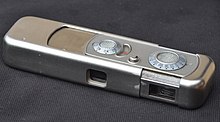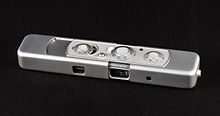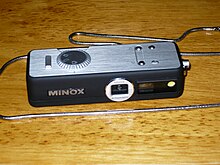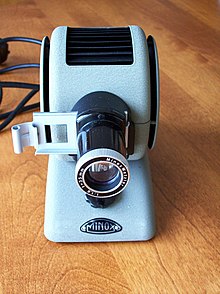Minox
| Minox
|
|
|---|---|
| legal form | GmbH |
| Seat | Wetzlar , Germany |
| management | Wolfgang Venzl |
| Number of employees | approx. 30 |
| Branch | Observation cameras, sports optics |
| Website | www.minox.com |
Minox is a German manufacturer of trail cameras and other optical devices with the same brand name . The classic model of a secret or spy camera is combined with the miniature cameras from Minox . After the successful 1970s, when Minox had a good 1000 employees, only around 30 employees now work at the company headquarters in Wetzlar . Today Minox is primarily a manufacturer of long-range optical products for nature observation and hunting ( binoculars and riflescopes ).
history
1936 constructed Baltic German Walter Zapp in Tallinn a camera - prototype . This original Minox initially used an even smaller film format of 6.5 mm × 9 mm. From 1938 the camera, now in the 8 × 11 format, was initially produced in Riga at VEF (Valsts elektrotehniskā fabrika) . Around 17,000 cameras of this model had been manufactured by the time the war broke out. Due to the events preceding the Second World War, Zapp moved to Hesse in March 1941 . He carried the wooden model and a copy of the first series model with him.
In 1945 Zapp founded Minox GmbH Wetzlar and continued the production of his miniature camera . The small company moved to nearby Heuchelheim in the Gießen district at the end of 1948 . A few months later, in 1950, Zapp turned his back on his company after differences with the partner and tobacco manufacturer Rinn & Cloos . Meanwhile, the Minox A spy camera became a success. In 1951, 180 employees were already working at Minox, four years later 560 people.
In 1974 the company presented its first 35mm camera . The Minox 35 EL met with great demand. The model was further developed in the following years. But the high production costs in Germany and the falling price level due to the great competition in the compact camera segment forced Minox to file a settlement application with the Giessen District Court on November 21, 1988 . The bankruptcy administration reduced the number of employees to almost 300. At the same time, the company's founder, Zapp, was hired as a designer.
In 1996 Minox returned to Wetzlar. In addition, the street to the new location in the Westend industrial park was renamed Walter-Zapp-Straße . On April 1, 1996, Leica Camera AG from Solms bought the strengthened company. Minox was incorporated as an independent subsidiary.
In 2001, the camera manufacturer got into digital photography and launched a digital compact camera, the DC 1311 . A management buy-out followed in the same year . Thorsten Kortemeier became the new managing director. Minox broke away completely from Leica in 2005.
In 2013, Thorsten Kortemeier founded German Sports Optics GmbH (GSO) based in Wetzlar, to which he brought Minox GmbH , together with the then L&O Hunting Group, which also included Blaser Jagdwaffen GmbH (compare L&O Holding ). L&O brought the company Optronika from Biebertal, a small developer and manufacturer of high-quality rifle scopes, into the GSO. Since then, Minox has belonged 100% to the Blaser Group and the GSO develops and builds riflescopes for Minox. On January 1, 2019, Wolfgang Venzl took over the management.
Products
Negative size 8 mm × 11 mm
The Minox 8x11 series is a family of different miniature cameras based on a film format of 8 mm × 11 mm.
In the original post-war model Minox A followed by numerous improved versions with new features (including Minox B with selenium cells - light meter from 1958, Minox C with electronic automatic exposure from 1969, Minox LX from 1978). An even smaller variant is the Minox EC, manufactured from 1981.
Negative size 24 mm × 36 mm
In 1974 the first 35mm camera , the Minox 35 EL, was introduced. It took over the title of the smallest camera for 35mm films from the Rollei 35 . Even Minox was surprised by the success of the small, lightweight camera, which is also pocket-friendly thanks to lens protection. In the following years, several other models of the 35 series were developed, some of which were produced until October 2002. Inventories are sold to this day (as of July 2007). An auto-focus version, however, was unsuccessful. The Minox 35 was copied as "Kiev 35" in the Ukraine from the end of the 80s. The shapes of both cameras differ slightly from each other, e.g. B. the back panels cannot be exchanged and Minox flashes do not fit on Kiev housings. The dimensions were therefore probably taken from the original without manufacturer documents - a common procedure in the Soviet camera industry since the FED.
Slide projectors
Minox also produced slide projectors to match its own (slide) film formats, for example the 3001 model.
Microfiche (micronegative) reader
At the beginning of the 1980s, portable reading devices - weighing approx. 10 kg - for microfiches were brought onto the market under the name of Mikroplan case device reader type 32689/32676 . The screen had a reading area of 34 × 31 cm, W × H. A 12 V, 50 watt halogen lamp was used as the light source. The devices could be operated with 115/220 volt ~ or with 12/24 volt (universal or NATO plug). 32689 could read microfiche with the dimensions 18 × 24 cm and type 32676 with 10.5 × 14.8 cm. With the help of interchangeable lenses, 24, 42 and 48 times magnifications could be generated. The devices were mainly used by federal and state authorities as well as in warehouse management and documentation areas of companies.
APS format
Most recently, Minox produced a number of compact cameras that used the APS format . All cameras in the CD series were equipped with high-quality lenses (such as the Minoxar systems known from the Minox 35 series), automatic film transport, program-controlled central shutter, autofocus and electronic flash with pre-flash technology. Around 2001 the film format disappeared from the market, and Minox no longer built any new APS cameras.
Digital photography
The company has been represented in the field of digital photography since 2003 with some models based on its own designs (DC series). In the meantime, 29 different models have been produced. The cameras are predominantly equipped with autofocus -Minoctar lenses that go back to the traditional Minotar and Minoxar lenses of the Minox 35 series. Examples are the compact camera DC 8122 with 8.1 megapixel resolution and 6x optical zoom and the DC 1011 with 10 megapixel image resolution. Minox also refines digital cameras with 24 carat gold-plated housings set with diamonds (DC 1011 Carat / DC 4211 Gold). The digital classic camera Leica M3 has now been in its fourth generation since photokina 2006, which is a miniaturized version of the Leica as a digital camera by Minox .
In 2008 Minox introduced the digital camera module DCM for the area of digiscoping . This allows you to take digital photos and videos with a spotting scope . In the same year the optics company presented the Minox DSC at the photokina. This digital spy camera has the dimensions 86 mm × 29 mm × 20 mm and is therefore similar in size to the cameras of the 8 mm × 11 mm series. Due to its design, which was created in collaboration with Volkswagen , the DSC was awarded both the red dot design award and the Design Plus Award .
Camera replicas
In the meantime, Minox also produces historical replicas of famous cameras on a scale of 1: 3. These fully functional replicas in miniature format are offered under the name Classic Camera Collection both as miniature cameras with Minox 8 × 11 film and as digital cameras .
So far, the company has made replicas of Leica M 3, Rolleiflex MiniDigi, Rolleiflex AF 5.0, Hasselblad SWC, Contax I, Leica If, Leica IIIf.
Long-range optics
In 1990 the pocket telescope Minox T8 developed by Zapp came onto the market. The monocular was manufactured in two versions, both with a plastic housing and with an aluminum housing (referred to as T8L ). The name of the pocket telescope goes back to eight times magnification.
In 1993 the product range was expanded to include the binoculars product category , and spotting scopes followed in 1999 . The company also produces macroscopes and night vision devices .
Increasing concentration on long-range optics: From the year 2000, parallel to the digitization of the photo market and the subsequent partial collapse of the traditional photo market, there was an ever greater concentration on products from the long-range optics sector. In 2017, the photo market no longer played a significant role for Minox, with the exception of wildlife cameras (photo traps). Rather, the hunting optics (including, and in particular scopes ) become more and more important.
See also
literature
- Hubert E. Heckmann: MINOX - Variations in 8 × 11. A manual for collectors and users. 2nd edition, Wittig Fachbuchverlag, Hückelhoven 2004, ISBN 3-88984-122-8 (today considered the best MINOX book on the market worldwide).
- Hubert E. Heckmann: MINOX The Queen of Spy Cameras, Variations in 8x11. 2nd English Edition. Wittig Books 2012, ISBN 978-3-88984-153-7
- Rolf Kasemeier: Small MINOX - Big Pictures. 5th edition, Lindemanns, Stuttgart 1996, ISBN 3-89506-153-0 (reprint of the edition of Heering-Verlag, Seebruck 1974).
- Morris Moses, John Wade: Spycamera - The Minox Story. Second edition . 2nd edition, Hove Photo Books, Denver CO 1998, ISBN 1-874707-28-6 .
- Gerhard Krüll: The MINOX friend 1–20. Gustav Hinsen GmbH, Düsseldorf (bound reprint of the booklets that appeared between 1958 and 1970).
- 1. German MINOX Club eV (ed.): Association magazine MINOX Freund . Regular insider magazine from 1993; has only been given to club members since 2007.
- Peter Eberhard: Octahedron, Spy-cam Sketches. Minox 8 × 11. Introduction . Clemens Stephan Marti. edition peer, Lucerne 2012, ISBN 978-3-905942-07-1 .
Web links
- Official website
- minoxclub.de: Operating instructions, tips and collector's literature
- VEF Minox Riga Fan Website (English)
- The Minox cameras at the Aperture and Time Forum
- Minox - the way to a revival
Individual evidence
- ↑ dpa: Leica and Minox want to make up ground , In: Gießener Allgemeine Zeitung of September 16, 2008, p. 32
- ↑ MINOX spy camera the myth lives on (from 0:02:00) on YouTube , accessed on June 11, 2018.
- ↑ a b Minox Germany - History
- ↑ digitalkamera.de: Minox introduces the DC1311 digital camera
- ^ Alan Haley: MINOX added to the Blaser Group portfolio. In: Blaser Group GmbH. Retrieved March 12, 2019 .
- ↑ Change in the management - MINOX GmbH - press release. Retrieved March 1, 2019 (German).
- ↑ red dot online: Minox DSC digital camera ( page no longer available , search in web archives ) Info: The link was automatically marked as defective. Please check the link according to the instructions and then remove this notice.
- ↑ MINOX DSC spy camera wins design award at the Marketing & Services trade fair in Frankfurt ( Memento of the original from October 30, 2007 in the Internet Archive ) Info: The archive link was inserted automatically and has not yet been checked. Please check the original and archive link according to the instructions and then remove this notice.
- ↑ Model description for the Minox T8
Coordinates: 50 ° 33 ′ 7.1 ″ N , 8 ° 28 ′ 37.2 ″ E










